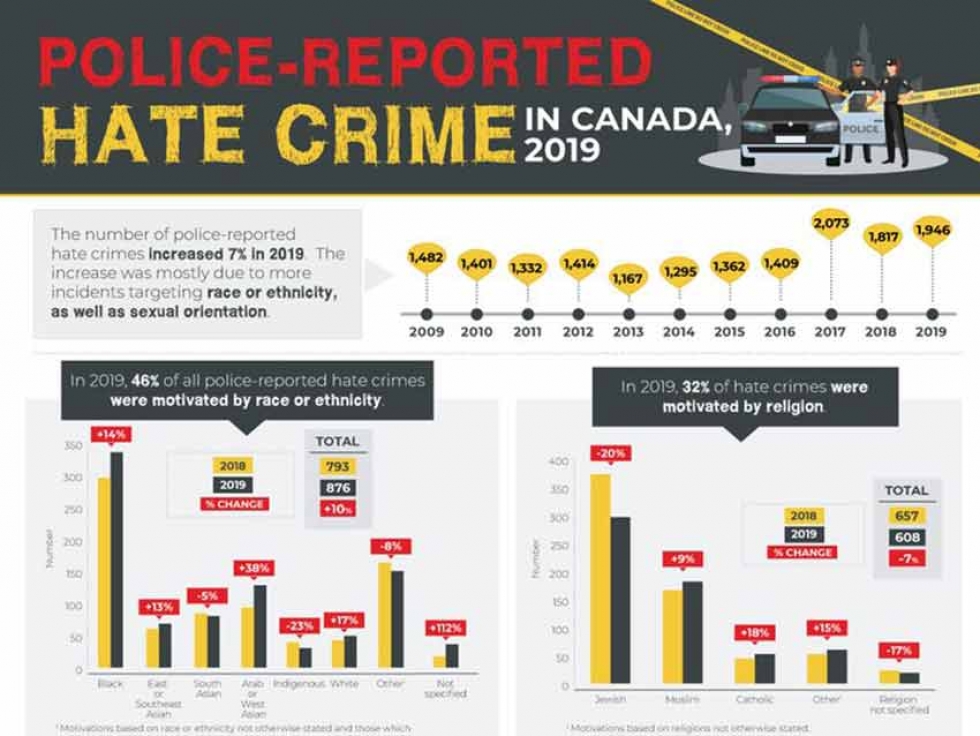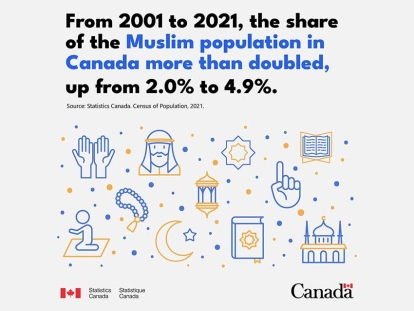 Infographic: Police-reported hate crime in Canada, 2019
Statistics Canada
Infographic: Police-reported hate crime in Canada, 2019
Statistics Canada
Apr
Statistics Canada releases analysis of police-reported hate crimes in Canada for 2019
Written by Statistics Canada[On March 29], Statistics Canada released a detailed analysis in the Juristat article "Police-reported hate crime in Canada, 2019" and the accompanying infographic "Infographic: Police-reported hate crime in Canada, 2019."
There were 1,946 police-reported hate crimes in Canada in 2019, up 7% from a year earlier. Other than a single peak of 2,073 hate crimes in 2017, police-reported numbers are the highest since 2009.
Statistics Canada collects data on the number and nature of hate crimes reported to police in any given year and monitors trends over time. The following statistics from 2019 do not reflect the large-scale societal impacts, both nationally and globally, of the COVID-19 pandemic, as this information is not yet available. The 2019 police-reported hate crime data will, however, be a key reference point for 2020, to identify possible changes in Canadian crime patterns as a result of factors related to the pandemic.
Results from a recent crowdsourcing survey show that, since the start of the pandemic, the proportion of participants designated as visible minorities who perceived an increase in race-based harassment or attacks was three times larger than the proportion among the rest of the population (18% versus 6%). This difference was most pronounced among Chinese (30%), Korean (27%), and Southeast Asian (19%) participants. In addition, some police services and media outlets, such as those in Vancouver (PDF 1,787 KB), Ottawa and Toronto (PDF 1,702 KB), have indicated significant increases in hate crime incidents in 2020.
The following are some highlights from the analysis:
Hate crimes target the integral and visible parts of a person's identity and may disproportionately affect the wider community. A hate crime incident may be carried out against a person or property and may target race, colour, national or ethnic origin, religion, sexual orientation, gender identity or expression, language, sex, age, mental or physical disability, or any other similar factor. In addition, four specific offences are listed as hate propaganda or hate crimes in the Criminal Code of Canada: advocating genocide, public incitement of hatred, willful promotion of hatred and mischief motivated by hate in relation to property used by an identifiable group.
Police-reported hate crimes motivated by hatred of a race or an ethnicity increase
Individuals designated as visible minorities generally report higher levels of discrimination than the non-visible minority population (20% versus 12%). Specifically, those who identified as Arab or Black were most likely to report having experienced discrimination, with four in five Black Canadians who had experienced discrimination indicating that their race or skin colour was the basis of the discrimination.
Almost half (46%) of all police-reported hate crime was motivated by hatred of a race or an ethnicity in 2019. Police reported 876 crimes motivated by hatred of a race or an ethnicity, up 10% from 2018, and 2 fewer than the record high in 2017. The rise was largely attributable to 40 more hate crimes targeting the Black population (+14%) and 35 more incidents targeting the Arab and West Asian populations (+38%).
With 335 police-reported incidents, hate crimes targeting the Black population reached their highest number recorded dating back to 2009. Hate crimes targeting the Black population accounted for 18% of all hate crimes in Canada, and this population was the most targeted group overall in 2019. Ontario (+29 incidents) and British Columbia (+16 incidents) accounted for the largest increases in hate crimes against the Black population, while Alberta (-19 incidents) reported the largest decrease.
The number of police-reported hate crimes against the Arab and West Asian populations rose from 93 to 128, following a 35% decrease a year earlier. This was the second-highest number dating back to 2009. These crimes accounted for 15% of hate crimes targeting race or ethnicity, and 7% of all hate crimes in 2019.
While the number of hate crimes targeting race or ethnicity rose in 2019, victimization data from the same year suggest that population groups designated as visible minorities were significantly less likely to report having a great deal of confidence in the police (35%), compared with non-visible minorities (44%). Perceptions of personal safety, prior victimization or discrimination, and confidence in the police can all impact the likelihood of an individual reporting a crime to the police.
Hate crimes targeting religion down for the second year in a row, with fewer anti-Semitic hate crimes
In 2019, 608 hate crimes targeting religion were reported by police, down 7% compared with 2018. Although this was the second year-over-year decrease in a row, following a peak of 842 incidents in 2017, the number was higher than those recorded prior to 2017. Victimization information has shown that people affiliated with a non-Christian religion were significantly more likely than Christians to report having experienced discrimination on the basis of their religion (11% versus 1%).
Following a 63% jump in 2017 and a 3% increase in 2018, the number of incidents targeting the Jewish population decreased 20% in 2019, from 372 to 296. The decline was the result of fairly widespread decreases, including fewer incidents in Alberta (-29), British Columbia (-20), Ontario (-19) and Quebec (-18). While police-reported metrics indicate a decrease in hate crimes targeting the Jewish population, an annual audit conducted by B'Nai Brith Canada reported a record number of anti-Semitic incidents for the fourth consecutive year.
In contrast, following a large decrease in hate crimes against the Muslim population in 2018, police reported 15 more incidents in 2019, for a total of 181 (+9%). The increase in police-reported hate crimes against Muslims was largely the result of more incidents in Quebec (+15 incidents).
Violent incidents targeting the Muslim population were more likely than other types of hate crimes to involve female victims. From 2010 to 2019, almost half (47%) of victims of violent hate crimes targeting the Muslim population were female, compared with one-third (32%) of all hate crime victims.








_1767359705.png)





